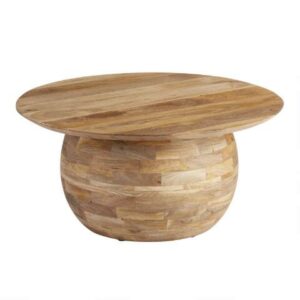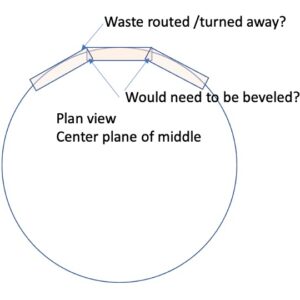How did they make this? AKA – The chump’s been stumped.
World Market sells a coffee table that has a spherical pedestal. Link and picture attached.
I’ve spent hours studying it trying to figure out how they made it, and if I were to try and re-create it how I would go about doing it. To my eye, it looks like it is face grain out, glued on edge grain/end grain, and to be a sphere each strip of wood would need to have been precisely beveled to the angle needed to build up a spherical shape. Even then, it would be a very faceted piece, with the only portion of each wood strip actually falling on the outside radius being in the center of the outside face. My guess is that it is assembled using wood scraps from some other manufacturing process, as a repurposing of otherwise wasted material, but still, it’s really caught my attention on how it was fabricated.
Conundrum #1 – Wood prep, layup, and clamping. It seems that the stock would have to be fairly thick so that after beveling there is still enough wood to work with for glue up. If the base were say 24″ in diameter, a curve touching the outside of the face in the center of that segment would have to cut nearly half the stock out to meet with the next wooden strip at the ends. My guess is the stock would need to be perhaps be 1-1/2″ thick?
How would one clamp this? without the whole thing just squeezing out of position? Even if it were hollow with no internal structure, I’d think there would have to be something keeping each layer of segments in place.
There appears to be a ‘seam’ in the middle of the pedestal, suggesting they are made in halves and then glued together. Maybe a bowl is turned upside down and the wooden pieces are laid out against the bowl as a form?
Conundrum #2 – It would seem that this piece may have been turned on a large lathe, or at very least on some turntable & router base that is also curved so that the router could be slid up and down the face of the curve as the base is rotated so the corners and ends of the wooden segments get knocked off. I attached a drawing to try and better explain this.
Conundrum #3 – If I did decide to move forward, please check my math… The pedestal alone would need a ton of wood. If a sphere has 4*pi*r^2 of surface area. So at 24″ diameter that’s 4*3.14*12^2 or 1809 square inches. Assuming 1.5″ strips of face grain for each layer=1206 inches of wood segments. Divide that by 12 and we get feet of 1.5″ wood segments, which comes to: 100′. Figuring boards came in 5′ lengths and were 6″ wide, then I’d for sure get 3 rips out of the board – so 100’/(5’boards*3rips/board) = 6.7 boards – so 7 boards, at what ever thickness would be necessary to enable at least leave 1/2″ of edge to glue on.
If anyone has ideas about how this base was constructed and/or any pictures that could help me envision how this piece would have been manufactured I’d really appreciate it.
Best,
Hudson

















Replies
Search "segmented bowl turning" on this site.
Thank you for the reply. It did actually help me envision what they probably did. It is amazing what they can do with inexpensive labor. I can't imagine the time it took to construct a 'bowl' this size, or the size of the machine and tooling to turn it, especially for $400 delivered.
Some things that can be done in large overseas factories with industrial sized CNC machines and lathes are very difficult to recreate in small shops. This may be one of them.
You have obviously put a lot of thought into this, more than I'm going to do, and your assessments seem pretty solid, although I'm not sure I agree with your math on wood needs but it's too early to test my brain that much. I would probably layout the rings in SketchUp to calculate my wood needs.
It would be simple enough to construct a series of rings, I would use a Domino or biscuit at the joints to aid alignment. I might consider roughing out the circle on my bandsaw or even a portable jigsaw might work.
Once the rings are assembled it becomes a matter of how you shape the curve, no simple feat. I can imagine a sled that rides on two circular rails attached to what would be the top and bottom of the base, but I can forsee some potential pitfalls, primarily being able to get enough bit projection to do the job.
If you preshaped the rings on the bandsaw it might be possible to use a spokeshave and handplanes to achieve the final shape but you would need to be extremely careful in laying out your rings to try to keep grain issues to a minimum.
Another option would be to use an aggressive sander such as a Festool Rotex to rough out the profile, refining it with a standard RO.
Anyway I look at this it is a bear of a project and not something you put together in a weekend, maybe a year's worth of weekends depending on how many jigs and other guides need to be made and tested.
Thank you for the detailed and patient reply. I'll have to consider if the merits of using this proposed project as an excuse to pitch to CINCHOME the benefits of investing in a domino!
This may be a commission I turn down. Friends saw it in a catalogue and were interested in having me make it for them to lend some special meaning to their home.
Have a great day.
Hudson
I have turned down scores of "commissions" from friends and family for things like this. You could not buy poplar for this project for $400, and the week of your time has no value at all. I'd order it for them before I built it.
That is why I pretty much just make what I make for my home or give as gifts to family. As such, I am less inclined to care how much of my time is spent.
Oh, you could never make money doing one of these at home. I'd guess there is no labor by whoever makes the one in the picture, either. I'd bet it's highly computerized.
Have you ever seen the wood "panels" that Home Depot sells? In a 2' by 4' "solid wood panel" I counted 52 pieces of wood. Finger jointed end to end and side to side, just a mass of scraps glued up and sanded flat. Doing that by hand would cost a fortune. But someone has a machine that mills all the parts and glues them up, dirt cheap. That's analogous to what they've done with your table.
If you wanted to make one for yourself, have at it. But you'd have to charge a fortune for it to break even.
I don't know anyone I like enough to make one of those for.
Still Laughing. Thank your some end of year humor. You are right of course. If I liked the shape more maybe but it's not to my taste at all. I made this on a commission too and it was much more to my liking.
Nice!
I'm just as impressed that it's made of mango. Thats pretty expensive wood here.
I don't often make segmented pieces out of construction lumber, but this planter made from 2x4 scraps is the same as the table in the OP. Nothing special about any of it, it's just bigger.
This is 16" diameter
Check out this Ben Prowell You Tube video.
https://www.youtube.com/watch?v=YwF_6Gv6HV8
Great video, thanks. Horrific sound track... I need a drink. Happy New Year.
That was fantastic! Thanks for sharing.
Ben Prowell did an interview on the Against the Grain podcast at one point. Was enjoyable. He trained at North Bennet St. School and works with his father about 90 minutes from where I live.
“[Deleted]”
Ashley Harwood also has at least 1 video on YouTube showing the process for turning very large tables, maybe a little different than this piece, but it shows what's possible. It isn't possible to do it in the US for that price however. It would most likely be a custom piece that would be thousands of dollars.
Frank Howarth on youtube is the master of spheres.
Late to the party, but since it's come up, I'm going to recommend Olivier Gomis as a great woodworker with the lathe - he has done some enormous projects with the segmented method.
Quite good videos to watch too.
https://www.youtube.com/@OlivierGomis
This forum post is now archived. Commenting has been disabled